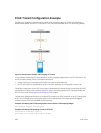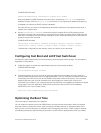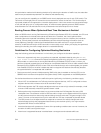When the system comes up, it is expected that there will be no dynamic ARP or ND database to restore.
The system boot up mode will not be fast boot and
Unexpected Reload of the System
When an unexpected or unplanned reload occurs, such as a reset caused by the software, the system
performs the regular boot sequence even if it is configured for fast boot. When the system comes up,
dynamic ARP or ND database entries are not present or required to be restored. The system boot up
mode will not be fast boot and actions specific to this mode will not be performed.
Software Upgrade
When fast boot is used to upgrade the system to a release that supports fast boot, the system enables the
restoration of dynamic ARP or ND databases that were maintained in the older release from when you
performed the upgrade and the ARP and ND applications identify that the system has been booted using
fast boot.
LACP Fast Switchover
For fast boot, the operation of LACP has been optimized. These LACP optimizations are applicable even
when fast boot is not enabled when a system reload is performed. These enhancements are controlled
using the fast-switchover option that is available with the lacp command in Port Channel Interface
Configuration mode. When LACP ‘fast-switchover’ is enabled on the system, two optimizations are
performed to the LACP behavior:
• The wait-while timer is not started in the ‘waiting’ state of the MUX state machine. The port moves
directly to the ‘attached’ state.
• The local system moves to the ‘collecting’ and ‘distributing’ states on the port in a single step without
waiting for the partner to set the ‘collecting’ bit.
Changes to BGP Multipath
When the system becomes active after a fast-boot restart, a change has been made to the BGP multipath
and ECMP behavior. The system delays the computation and installation of additional paths to a
destination into the BGP routing information base (RIB) and forwarding table for a certain period of time.
Additional paths, if any, are automatically computed and installed without the need for any manual
intervention in any of the following conditions:
• After 30 seconds of the system returning online after a restart
• After all established peers have synchronized with the restarting system
• A combination of the previous two conditions
One possible impact of this behavior change is that if the amount of traffic to a destination is higher than
the volume of traffic that can be carried over one path, a portion of that traffic might be dropped for a
short duration (30-60 seconds) after the system comes up.
Delayed Installation of ECMP Routes Into BGP
The current FIB component of Dell Networking OS has some inherent inefficiencies when handling a
large number of ECMP routes (i.e., routes with multiple equal-cost next hops). To circumvent this for the
configuration of fast boot, changes are made in BGP to delay the installation of ECMP routes. This is done
Flex Hash and Optimized Boot-Up
347


















